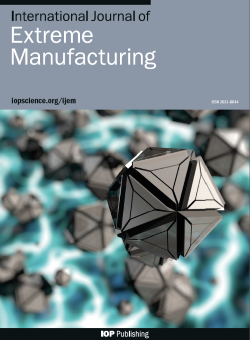用于无像素锯齿表面制造的振动辅助釜式光聚合技术
IF 16.1
1区 工程技术
Q1 ENGINEERING, MANUFACTURING
引用次数: 0
摘要
基于掩模图像投影的大桶光聚合(MIP-VPP)具有成本低、分辨率高和材料范围广等优点,因此在工业和教育领域很受欢迎。最近,采用液晶显示器(LCD)的 MIP-VPP 技术受到了越来越多的关注,尤其是在业余爱好者和教育领域,它逐渐取代了数字微镜设备(DMD),现在已开始用于工业环境。然而,基于液晶显示器的 MIP-VPP 存在明显的像素混叠问题,这是由于液晶显示器的离散图像像素及其在 MIP-VPP 机器中的直接接触配置造成的,从而导致 3D 打印部件表面粗糙。在此,我们提出了一种振动辅助 MIP-VPP 方法,该方法利用微尺度振动使 VPP 构建平台上基于 LCD 的掩模图像的光强分布均匀化。通过保持相同的制造速度,我们的技术可以生成更平滑、无像素化的掩模图像,从而减少三维打印部件的平面和边界段的粗糙度。通过光强建模和模拟,我们得出了液晶掩模图像的最佳振动模式,随后通过实验进行了验证。我们评估了使用振动辅助方法生产的部件的表面纹理、边界完整性和尺寸精度。MIP-VPP的表面明显更加光滑,边界粗糙度得到改善,从而提高了打印质量,使其在三维打印光学设备生产等领域的应用前景广阔。本文章由计算机程序翻译,如有差异,请以英文原文为准。
Vibration-assisted Vat Photopolymerization for Pixelated-aliasing-free Surface Fabrication
Mask image projection-based vat photopolymerization (MIP-VPP) offers advantages like low cost, high resolution, and a wide material range, making it popular in industry and education. Recently, MIP-VPP employing liquid crystal displays (LCDs) has gained traction, increasingly replacing digital micromirror devices (DMDs), particularly among hobbyists and in educational settings, and is now beginning to be used in industrial environments. However, LCD-based MIP-VPP suffers from pronounced pixelated aliasing arising from LCD's discrete image pixels and its direct-contact configuration in MIP-VPP machines, leading to rough surfaces on the 3D-printed parts. Here, we propose a vibration-assisted MIP-VPP method that utilizes a microscale vibration to uniformize the light intensity distribution of the LCD-based mask image on VPP’s building platform. By maintaining the same fabrication speed, our technique generates a smoother, non-pixelated mask image, reducing the roughness on flat surfaces and boundary segments of 3D-printed parts. Through light intensity modeling and simulation, we derived an optimal vibration pattern for LCD mask images, subsequently validated by experiments. We assessed the surface texture, boundary integrity, and dimensional accuracy of components produced using the vibration-assisted approach. The notably smoother surfaces and improved boundary roughness enhance the printing quality of MIP-VPP, enabling its promising applications in sectors like the production of 3D-printed optical devices and others.
求助全文
通过发布文献求助,成功后即可免费获取论文全文。
去求助
来源期刊

International Journal of Extreme Manufacturing
Engineering-Industrial and Manufacturing Engineering
CiteScore
17.70
自引率
6.10%
发文量
83
审稿时长
12 weeks
期刊介绍:
The International Journal of Extreme Manufacturing (IJEM) focuses on publishing original articles and reviews related to the science and technology of manufacturing functional devices and systems with extreme dimensions and/or extreme functionalities. The journal covers a wide range of topics, from fundamental science to cutting-edge technologies that push the boundaries of currently known theories, methods, scales, environments, and performance. Extreme manufacturing encompasses various aspects such as manufacturing with extremely high energy density, ultrahigh precision, extremely small spatial and temporal scales, extremely intensive fields, and giant systems with extreme complexity and several factors. It encompasses multiple disciplines, including machinery, materials, optics, physics, chemistry, mechanics, and mathematics. The journal is interested in theories, processes, metrology, characterization, equipment, conditions, and system integration in extreme manufacturing. Additionally, it covers materials, structures, and devices with extreme functionalities.
 求助内容:
求助内容: 应助结果提醒方式:
应助结果提醒方式:


